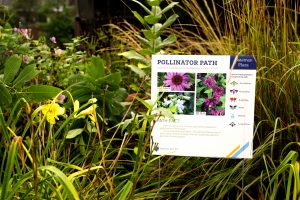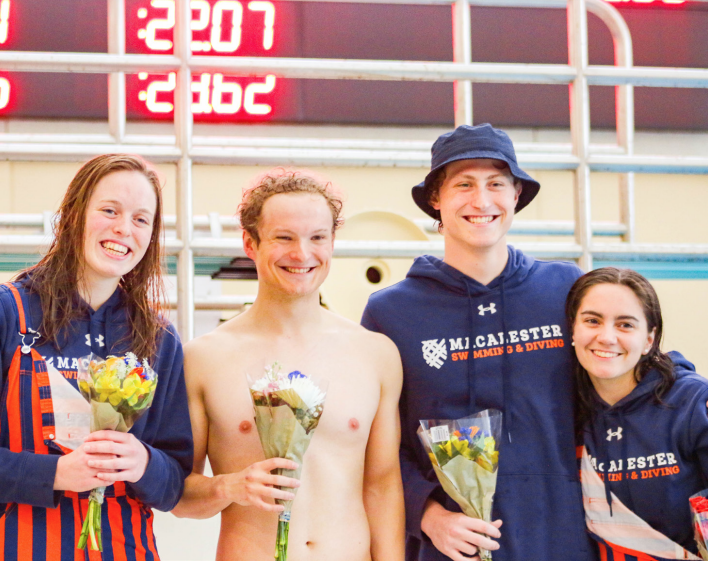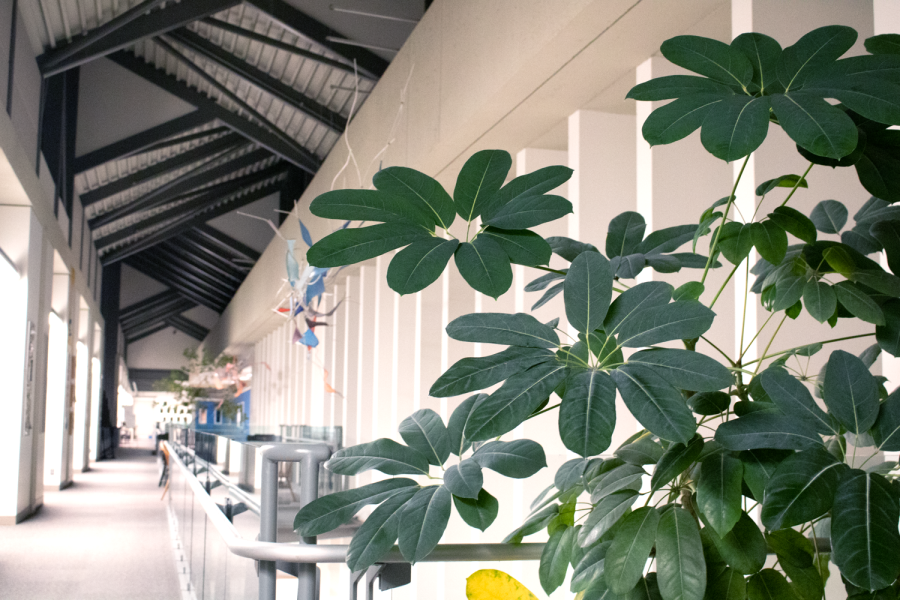Standing in front of the prairie behind the Olin-Rice Science Center on September 12, two students – Collin Dobie ’19, dressed in a beekeeping suit, and Aubrey Arnt ’21, wearing a bee costume – officially inaugurated Macalester’s new Pollinator Path.
The Pollinator Path is a Sustainability Office initiative to create a map outlining the eight pollinator-friendly gardens on campus, each location marked with a sign. Their goal is to increase awareness of Macalester’s sustainable landscaping initiatives and to encourage future landscaping projects to choose plants that are pollinator-friendly.
Last spring, former MCSG Sustainability Officer Molly Flerlage ’18 encountered a pollinator path at the University of St. Thomas, and, impressed, approached Sustainability Manager Suzanne Savanick Hansen about bringing the project to Macalester.

Flerlage and Hansen met with St. Thomas biology professor Doreen Schroeder and Greenhouse Manager Catherine Grant, who developed the university’s project, to discuss the idea.
The pair eventually passed the project on to Arnt and Dobie, who were working in the Sustainability Office for the summer.
“Molly had found lists of plants from facilities for a few of the landscaping sites on campus and we were able to get some more information from them,” Dobie said. “It was just a process of seeing what was supposed to be there and what had survived over the past few years, since most of those plants were [planted] in 2011. Then, once we figured out what was actually growing, we needed to figure out which of those plants were pollinator-friendly.”
Incorporated throughout the campus’ preexisting landscape are plants like coneflowers, bee balm and honeysuckle, which are all extremely attractive to pollinators.
The beds chosen for the Pollinator Path also had to include cover for insects to safely access the flowers and had to contain species with long and varied blooming seasons. For that reason, plants like catmint, which blooms twice during its growing season, are also featured in the path’s gardens.
Once sites with these plants were identified, Dobie and Arnt drafted the language for the signs that now identify the Pollinator Path beds and designed an informative page about the initiative on the Sustainability Office’s website.
Although the intention of the project was never to replant pre-existing beds, ideas about expanding the Pollinator Path have already begun to take shape.
“Since we started doing this, and started talking to facilities about it, they replanted the slope on Olin Rice, which we will add to the next version of our pollinator path map,” Hansen said.
At the end of the summer, Dobie and Arnt also helped to replant the native species garden on Macalester Drive behind the new theater building’s construction site. That location will be included in the next map.
Already there has been some interest from St. Catherine’s University and Hamline University in extending the path all the way to their campuses.
“Macalester has a pollinator path, St. Thomas has a pollinator path, we at least have some faculty interested at St. Kate’s and Hamline, so I think there’s a possibility of expanding this idea of a pollinator path through the other colleges,” Hansen said.
Looking even further into the future, Art and Art History Department Coordinator Kristi Fackel has already been in touch with Transition Mac-Groveland Union Park (T-MUP), a group of college students, staff and faculty as well as community members whose mission is to make the neighborhood a more sustainable place to work, study and live. They want to expand the project even further.
T-MUP has been in contact with the managers of Minnesota United FC, whose new soccer stadium will be just a few blocks from Macalester’s campus on the corner of Snelling and University.
“We decided it would be great if we could get this pollinator path going through the neighborhood and Hamline University is also really interested in installing one there,” Fackel said. “So I started thinking, up Snelling – how are we going to get it up that far and I got in touch with people at Minnesota United, they said they’d be more than happy to talk.”
Fackel brought Dobie and Arnt to Minnesota United headquarters for a meeting with Alyssa Anderson, the institution’s community relations coordinator, who expressed some interest in the project.
“They were very excited about it,” Fackel said. “[team owner, Dr. Bill] McGuire is really interested in butterflies, specifically.”
There was some concern, however, about the feasibility of incorporating the pollinator path at the new stadium. Planting beds might not be a feasible option with landscaping already planned for the site and while raised planters could be included, they generally need to be replanted every year and thus represent a higher maintenance cost.
Ultimately, the Pollinator Path project is ongoing, and although the first phase is over, everybody involved has a vision of what it could one day become.
“People in general, people in the Twin Cities, people across the country, are really concerned about pollinators,” Hansen said. “We are having such a decline in pollinators and it is dangerous for the pollinators but also for our own food safety.
“When we have 50 percent declines or 50 percent kill-offs in our managed bees, what’s happening to our non-managed bees,” she continued. “I think [the Pollinator Path] is a way we can have an impact both on helping our neighbors do the right thing in their own yards and the other colleges. I think we can have a real positive impact on at least our local area.”
Arnt and Dobie, both Twin Cities natives themselves, feel a personal stake in the project’s future and are both interested in continuing the project through T-MUP and onto their own property.
“I want a sign in my front yard,” Dobie said.
Although the intention of the project was never to replant pre-existing beds, ideas about expanding the Pollinator Path have already begun to take shape.
“Since we started doing this, and started talking to facilities about it, they replanted the slope on Olin Rice, which we will add to the next version of our pollinator path map,” Hansen said.
At the end of the summer, Dobie and Arnt also helped to replant the native species garden on Macalester Drive behind the new theater building’s construction site. That location will be included in the next map.
Already there has been some interest from St. Catherine’s University and Hamline University in extending the path all the way to their campuses.
“Macalester has a pollinator path, St. Thomas has a pollinator path, we at least have some faculty interested at St. Kate’s and Hamline, so I think there’s a possibility of expanding this idea of a pollinator path through the other colleges,” Hansen said.
Looking even further into the future, Art and Art History Department Coordinator Kristi Fackel has already been in touch with Transition Mac-Groveland Union Park (T-MUP), a group of college students, staff and faculty as well as community members whose mission is to make the neighborhood a more sustainable place to work, study and live. They want to expand the project even further.
T-MUP has been in contact with the managers of Minnesota United FC, whose new soccer stadium will be just a few blocks from Macalester’s campus on the corner of Snelling Ave. and University Ave.
“We decided it would be great if we could get this pollinator path going through the neighborhood and Hamline University is also really interested in installing one there,” Fackel said. “So I started thinking, up Snelling – how are we going to get it up that far and I got in touch with people at Minnesota United, they said they’d be more than happy to talk.”
Fackel brought Dobie and Arnt to Minnesota United headquarters for a meeting with Alyssa Anderson, the institution’s community relations coordinator, who expressed some interest in the project.
“They were very excited about it,” Fackel said. “[team owner, Dr. Bill] McGuire is really interested in butterflies, specifically.”
There was some concern, however, the feasibility of incorporating the pollinator path at the new stadium. Planting beds might not be a feasible option with landscaping already planned for the site and while raised planters could be included, they generally need to be replanted every year and thus represent a higher maintenance cost.
Ultimately, the Pollinator Path project is ongoing, and although the first phase is over, everybody involved has a vision of what it could one day become.
“People in general, people in the Twin Cities, people across the country, are really concerned about pollinators,” Hansen said. “We are having such a decline in pollinators and it is dangerous for the pollinators but also for our own food safety.
“When we have 50 percent declines or 50 percent kill-offs in our managed bees, what’s happening to our non-managed bees,” she continued. “I think [the Pollinator Path] is a way we can have an impact both on helping our neighbors do the right thing in their own yards and the other colleges. I think we can have a real positive impact on at least our local area.”
Arnt and Dobie, both Twin Cities natives themselves, feel a personal stake in the project’s future and are both interested in continuing the project through T-MUP and onto their own property.
“I want a sign in my front yard,” Dobie said.









Joan James • Sep 12, 2019 at 5:28 am
I am constantly invstigating online for posts that can aid me. Thx!
James Alsop • Sep 10, 2019 at 10:46 pm
I could not resist commenting. Perfectly written!
Paul Taylor • Sep 8, 2019 at 11:13 am
excellent points altogether, you just received a new reader. What could you recommend about your submit that you just made a few days ago? Any positive?
Tim • Aug 12, 2019 at 6:04 pm
Thanks I needed this
Loren Hysmith • Jul 22, 2019 at 6:34 pm
Mass parsite http://bit.ly/2W9CVkn